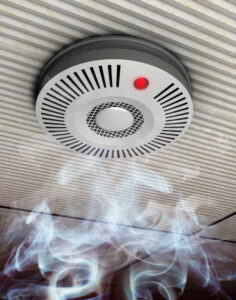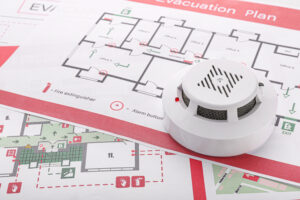Fire alarms are a must in any establishment. But just installing the fire alarm isn’t enough. You must also know the alert tones to know what it’s indicating. Otherwise, the total purpose of it would fail.
For example, do you know why fire alarm sounds like whoop whoop?
When the fire alarms sound like whoop whoop, it’s indicating that people need to evacuate. It’s rather an urgent message that says the building you’re staying at is not safe. You need to immediately evacuate the building and move to a safe place.
That’s the first look of our today’s discussion. Join us to learn more about how to deal with such emergency situations.
Let’s start!
What Whoop Whoop Sound Means In Fire Alarm?
Fire alarms have two types of fire alert signals. One sounds like BEEP, BEEP and the other is WHOOP, WHOOP. The WHOOP WHOOP sound in the fire alarm is the evacuation alert tone.
This means that the fire alarm is indicating that the building needs to be evacuated immediately. The whoop whoop alert sound usually comes after the beeping alert tone.
Because the beeping sound indicates an impending fire hazard emergency. The evacuation notice comes after. Neither of these fire alarms should be taken lightly.
What to Do When Fire Alarm Sounds Like Whoop Whoop?

If your fire alarm makes whoop whoop noise, be ready to evacuate the building. But when the fire alarm starts to ring, the first thing people experiences is chaos.
Everyone tries to evacuate the hazardous place at once and then accidents take place. On many occasions, we’ve seen people getting hurt from trying to evacuate from crowdy places.
This happens due to stress, panic, and fear. But when dealing with such situations you need to be calm and collected. And then follow a proper evacuation plan.
Many establishments keep the building map along with the evacuation plan posted in common areas. But depending on the situation, you may need to come up with one.
If you’re new to this, follow along. Because we’ll be giving you complete fire evacuation guidelines.
How To Make A Fire Evacuation Plan?

To make the evacuation plan successful you need to follow these steps.
Step-1: Alert Everyone
The first thing to do is to let everyone know about the impending danger before them. There are possibilities that someone might have missed the fire alarm.
For example, the fire alarm’s sound won’t help people with hearing disabilities. There might be elderly, bedridden people and children who won’t be able to help themselves.
Those who know about the situation should gather everyone together in a commonplace. So, no one is left out. Another important thing is to keep calm.
The person who’s informing others should be careful not to spread panic among others. But at the same time, they have to convey the urgency properly.
Step-2: Divide Responsibilities
This step is for large buildings and offices where a lot of crowds are gathered. Evacuating so many people without any guidance can cause more accidents.
That’s why it’s important to divide some responsibilities among some people who can guide others. There are some of the primary roles to be considered when making an evacuation plan.
These roles should be established beforehand for any large apartment or office. Keeping in mind that fire hazards can happen. These roles are-
Chief Fire Warden:
This person is responsible for overlooking the whole fire event. That includes planning & preparations. He’d also do a routine check on fire alarm systems and emergency exits.
If needed, do reset the emergency lights. He should also make sure nobody is left out during an emergency.
Assistant Fire Warden:
This person’s responsibility is to call the fire department and notify all the employees. He’s also responsible for the emergency communication system as the acting admin.
Route Guide:
Route guide makes sure which routes to take for evacuation. He also makes sure that it’s safe and leads the people out.
Floor Monitors:
Floor monitors are responsible to make sure the area is clear and nobody is left out. They ensure that all the employees have evacuated and report it to the chief warden.
When assigning these roles, make sure that the safety team is properly organized and reliable enough. They need to have the quality of acting quickly in such emergency situations.
They should also make sure to inspect fire extinguishers from time to time. For small households or establishments, assigning such roles might not be possible.
It is not even much needed. In a small community where people know each other, can help each other. Two or three people to lead everyone to a safe place is enough.
Step-3: Carry Safety Tools
While evacuating, you should carry some safety tools with you if possible. For example, a horn, fire extinguisher, keys to exits, torchlight, and smartphones.
These tools may help you if the situation is too dire. Many people don’t know how to use fire extinguishers. It would be best if you could learn to use them beforehand.
Step-4: Figure Out Scape Routes & Emergency Exits
Every building should have primary and secondary escape routes. These exit routes should have clear signs near them so people can find them easily. The emergency exit lights should stay on at all times.
It’s a good idea to mark the escape routes and emergency exits on the building map. Then post it in building common areas where everyone can see it.
One or a few people should check out their escape routes and make sure it’s safe. Then lead people out of the building. So that, people don’t find themselves at a dead end.
Step-5: Make a Communication Plan
Making a communication plan during an emergency is a very important step. It is to ensure that you can know if someone needs immediate help or to receive help.
Upon any fire emergency, someone needs to inform the fire department of the situation. They need to provide the proper location and the details of the situation.
Although it’s the assistant fire warden’s responsibility, you may not always have a safety team. In such cases, you must call 911 and the local fire department.
Even social media can be a reliable place to seek quick aid. Stay in groups so that everyone knows they have a communication medium.
Step-6: Follow-up & Report
This step comes after the evacuation is complete. Everyone should do a head count to see if everyone made it safe and sound. If someone is missing, they should immediately report it to the fire service.
Also, look out if anyone needs immediate medical attention. Call an ambulance to stand by for emergencies.
Things You Should Not Do While Evacuating From Fire
There are a few things that you should never do when facing a fire evacuation. Here’s the list-
Don’t Break Windows:
Do not attempt to break the window to get rid of the smoke. People think that it’ll allow the smoke to blow out. But opening the window allows more oxygen in.
So, the fire might grow even bigger. Rather, try to starve the fire as much as you can. Try to cover your nose and mouth with your hand to avoid inhaling smoke.
Don’t Open Hot Doors:
If you feel the heat on any door in your way, avoid opening it. Because chances are that the other side is also on fire. The door might be blocking it.
Opening the door will only help the fire to spread.
Don’t Go Back To Collect Belongings:
Never return to collect any belonging in fire emergencies. You may think you have the time to collect a few items. But anything unexpected can happen.
Fire can spread within minutes. So don’t take the risk.
Never Hide:
You must never hide if a fire takes place. Hiding makes it harder for the fire safety team to find you. It also limits your movements. Just because you don’t see the fire doesn’t mean you’re safe.
Don’t Use Elevators:
You might be tempted to use elevators but avoid doing so. Because fire can damage the ropes or the electrical system of the elevators. So, the power could be lost.
You may end up stuck in the elevator. So, always choose the stairs.
Other Things To Consider In Fire Evacuation

Consider Special Cases:
When making an evacuation plan make sure to think of disabled, elderly, and sick people. Keep things like a wheelchair, or crutches just in case. Even if there’s no one that fits into the categories.
Safeguarding The Assets:
If there are valuable assets that need to be protected, shift them to a fire-proof room. If there are no fireproof rooms then at least keep them in a fire-proof safe if unguarded.
To protect important business documents, use cloud storage. But do not do it with the risk of getting too late to evacuate. Only go for it if you’re sure about your life’s safety.
Frequently Asked Questions (FAQs):
Why does the fire alarm sound like cricket?
Fire alarms often make a chirp-like sound that resembles that of cricket noise. With three beeps or cricket noises, it alarms you about smoke in the air. For carbon monoxide, it rings 4 times. If it beeps once it means low battery.
What does PEEP mean?
PEEP is an abbreviation for Personal Emergency Evacuation Plan. It is the evacuation plan that is advised for people with special needs. For example, someone with disabilities or any mobility issues. Since they can’t follow the regular plan like others, it’s a specialized plan for them.
How long do fire extinguishers last?
Fire extinguishers last about 10 to 12 years and need to be replaced every 10 years. To find the expiration date, look at the cylinder body. The expiration date should be mentioned on the stamped label. The label is usually around the neck or under the plastic boot.
Conclusion
Now you know what to do when fire alarm sounds like whoop whoop. Keep calm and follow all the guidelines for evacuation. It would be best if you practice the evacuation plan once or twice a year.
So, when the emergency arises everyone knows what to do and how to deal with it. Stay happy, stay safe!

